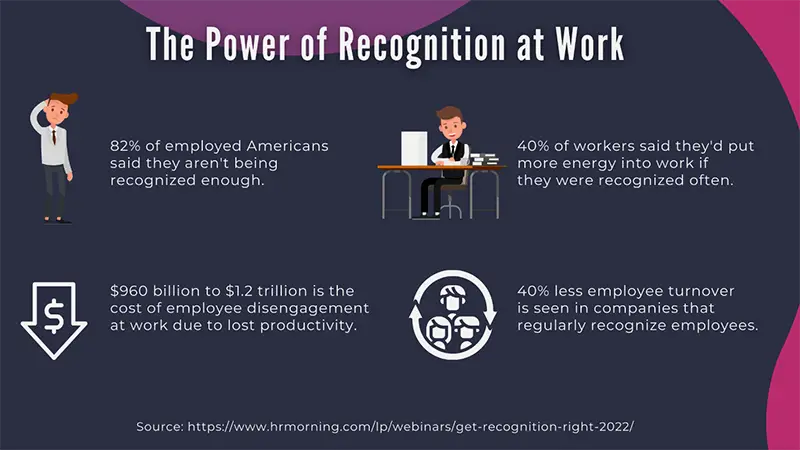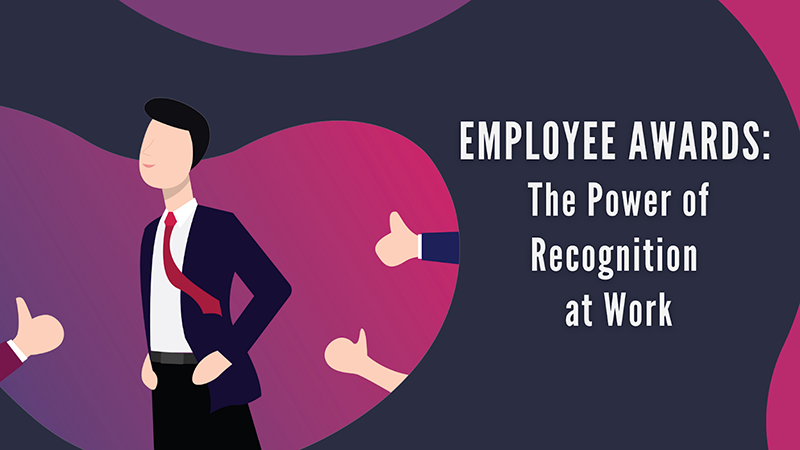Click here to get this post in PDF
Recognition in the workplace is a tool that is often overlooked and frequently undervalued. Employee recognition should be more than an expected award given at a regularly scheduled year-end event. Companies should be more thoughtful in developing ways to show appreciation to their employees in a consistent manner.
It is easy for an employer to get stuck in the regularly scheduled program of rewarding employees at company events or end-of-year meetings; that may be because it’s difficult to conceptualize just how motivating and loyalty-building workplace recognition can be. However, when you look into the star employee’s eyes as they receive an armful of employee awards or in a much-improved staffer’s smile after a simple compliment about their performance, you will soon see the power of recognition at work.
In this article, I will walk through recognition in the workplace, employee awards and how to use the power of recognition to improve your company. Read on to learn more.
What are Employee Awards?
Employee awards are a tangible form of employee recognition. These can be literal trophies given out at a company event, framed certificates or anything similar. The form they come in matters much less than what they communicate. When employers use them correctly, employee awards recognize employees for achievements or traits in the workplace that bring value to the company and its culture.
But what employees value has changed over the years. Today, employees want to be valued based on what they bring to the table. They want recognition for their work and talent. The value of an employee award is often in the recognition itself rather than the physical reward that comes along with it.
That said, there are right and wrong ways to give employee awards. Let’s look at some of the world’s most successful companies to understand how valuable employee awards can be when used correctly.
Disney, for example, has dozens of employee recognition programs. These programs offer awards in various formats, from trophies and phone calls from executives to shout-outs on Twitter and in the company newsletter.
Meanwhile, Google has created an entire program devoted to employee recognition. The program includes peer-to-peer recognition, a “Wall of Happy,” on-the-spot bonuses and personalized employee awards.
The popular coupons and online deals company Groupon has taken another approach to employee recognition. When an employee’s work anniversary — called a “Grouponiversary” at Groupon — comes around, the company gives the employee a personalized track jacket in the company color: bright green. It comes personalized however the employee wants it.
Why is Employee Recognition at Work Important?
Employee recognition is more than a tradition. However, companies should be more thoughtful in developing ways to show appreciation to their employees. The following studies exhibit the significance of employee recognition and the costs of not recognizing employees enough.
One study completed by Achievers found that 82% of employees say they aren’t being recognized enough. Employees want to feel needed, acknowledged and recognized for their work, and in business terms, that’s a market need — one that you and other leaders at your company can and should serve.

In return, one of the greatest benefits you will experience is quickly rising employee retention. A report from HR Morning finds that companies see as much as 40% less employee turnover when their managers recognize employees at least 1.8 times more often than their counterparts do.
The Power of Recognition: Does It Work for Employees?
When your employee awards and recognition structure aligns with your company’s mission and vision, you can see the true power of recognition at work. But, how far will the power of recognition go for your employees? If your employee awards and other forms of recognition align well with your company’s goals, the answer is quite far.
But there are plenty of ways to get recognition in the workplace wrong. If you, for example, award employees for achievements and traits that have nothing to do with — or even run counter to — the company’s goals and strategies, you may have happy employees, but you will not elevate the output of your business.
The employee experience you want to build, the brand your company has built, and the values the organization holds should all influence how you reward and recognize employees for their work
The Deep Benefits of Recognition at Work
The following are some of the benefits to expect from a well-developed employee recognition program:
- Collaboration and teamwork are incentivized, leading to greater output and innovation.
- Company culture is reinforced, defining the employee experience and building loyalty.
- Employee turnover decreases, saving the business on hiring and training costs.
- Employees are likely to be happier, which can increase productivity.
- Recruiting top-quality employees becomes demonstrably easier.
Alignment in this area connects your team members with the mission and goals of the entire organization — giving them a higher purpose and something to hold on to and work toward.
What is the Best Way to Award Employees?
It is no exaggeration to say that every employee wants to be recognized for their hard work and achievements. But they do not all necessarily want the same type of recognition. What one employee finds rewarding may not be rewarding to another. To give you some ideas, I’ve laid out a few examples of how to reward your employees in the section below.
What are Examples of Employee Rewards?
Consider the following examples of employee rewards and how you might use them within your organization:
1. Offer a public thank you. At Hartman Income REIT Management Inc., we publicly thank employees by giving out “coins.” These are usually gift cards, and we spend around $100,000 per year on them. The benefits of our employee recognition efforts are more than worth the cost.
2. Give out gift cards. Our gift card giving efforts have been enormously successful. Sending an employee a gift card to a place they love, perhaps their favorite coffee shop, can go an extremely long way.
3. Offer time off. Who doesn’t love time off? Most employees value free time, and when it’s free time sanctioned by their employer, the value increases. That’s why Hartman offers a generous time-off package to all employees.
4. Feature top employees on your company blog or newsletter. Disney isn’t the only company doing this. At Hartman, we recognize an employee of the month and a customer service superstar each month in our internal newsletter. Each award recipient also gets $100.
5. Buy the employee lunch. Buying someone’s lunch to thank them is a classic, but you can double the power of recognition here by going to lunch with them as their manager. A little one-on-one time and conversation can make an employee feel valued and appreciated for months.
6. Send a personalized note. Recognition in the workplace doesn’t have to be showy. A simple personalized thank-you note can deliver all the recognition of an employee awards show for some workers.
7. Send them flowers or their favorite snack or treat. If you can identify which snack, treat or type of flowers the recipient likes best, you can give them recognition and show them that you have been paying attention to their performance and who they are.
8. Buy them a new office plant. Plants are the office gift that keeps on giving, and if you buy a desktop or desk-side plant to recognize one of your employees, they will keep feeling the recognition every time they look at or water the plant.
9. Send them a book. Books make wonderful gifts, but for purposes of recognition at work, choose books that focus on professional development. This will show the recipient that you care about their career path and job growth.
10. Submit a donation to a nonprofit or charity of their choice. Every single one of your employees has a cause they care about. You can help them feel heard, valued and recognized by making a donation to a charity of their choice. That’s a form of recognition they won’t soon forget.
Recognition in the Workplace: How to Make Employees Do Their Best Work
Any seasoned manager or executive can think of dozens of reasons to keep employees happy, productive and feeling appreciated. From reduced turnover to increased productivity, the benefits of happy employees are difficult to overstate. And you can bring all of these benefits to your business with nothing more than a little recognition at work.
That’s the power of recognition. It goes a long way for your employees and, in turn, brings your company closer to achieving its mission, vision and goals.
To read more about motivating employees in the workplace, check out CEO Al Hartman’s two-part series on excellence in the workplace.
Also read:
Business Award Categories: Choosing the Best One for Your Brand
5 Ways to Give Your Employees Recognition
Why Small Business Awards Are Essential for Growth and Visibility
About the author
Al Hartman is the President, CEO, and Chairman of the Board of Directors at Hartman Advisors and the CEO of Hartman Income REIT Management, Inc. Learn more about Al Hartman and and follow Al Hartman on Twitter and LinkedIn.



